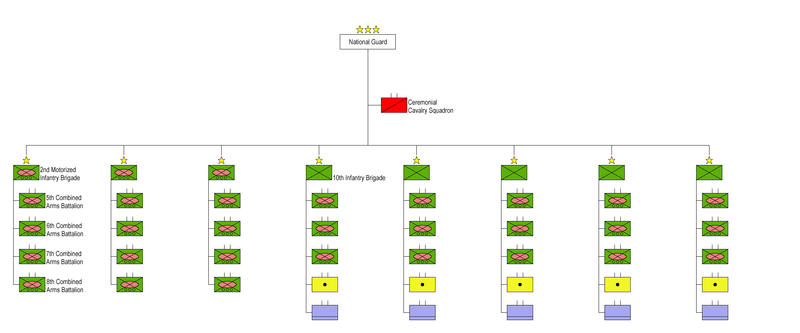| Saudi Arabian National Guard al-Ḥaras al-Waṭanī الحرس الوطني | |
|---|---|
| Founded | 1917s - May 2013 |
| Country | Saudi Arabia |
| Allegiance | Saudi Arabia |
| Branch | Army |
| Type | Land Force |
| Role | Land warfare |
| Size | 100,000 |
| Part of | King of Saudi Arabia |
| Garrison/HQ | Riyadh, Saudi Arabia |
| Nickname(s) | SANG, The White Army |
| Engagements | PSF intervention in Bahrain |
| Battle honours | |
| Commanders | |
| Commander | Prince Mutaib bin Abdullah |
| Notable commanders | King Abdullah |
The Saudi Arabian National Guard (Arabic language: الحرس الوطني, al-Ḥaras al-Waṭanī) (SANG, also known as the White Army) is one of the three major branches of the Armed Forces of the Kingdom of Saudi Arabia. The national guard is under the administrative control of the Ministry of the National Guard .The current Minister is Prince Mutaib bin Abdullah who was appointed to this position by the king on May the 27 of 2013.
Organization and roles[]
The Saudi Arabian National Guard is not under the control of the Ministry of Defense, as its command structure and communication network are separate and it reports directly to the king trough the Minister of the National Guard. It serves both as a defence force against external attack and as a security force against internal threats. Its duties include protecting the House of Saud, guarding against military coups, guarding strategic facilities and resources, and providing security for the cities of Mecca and Medina.
It has a standing force of 100,000 troops and a tribal militia of 25,000 troops. The SANG acts as the House of Saud's praetorian guard as its personnel are drawn from tribes loyal to the King and royal family. It is always commanded by a high-ranking member of the royal family. The force was extensively reorganized and retrained by the Vinnell Corporation (using over a thousand U.S. Vietnam War veterans) in the 1980s and performed well in the Persian Gulf War/Operation Desert Storm especially in the Battle of Khafji.
The United States' support for the SANG has been delivered both through private contractors and the U.S. Army's Office of the Program Manager Saudi Arabian National Guard Modernization Program.
Sandra Mackey, author of The Saudis: Inside the Desert Kingdom, stated that the National Guard was "an institution that ties the tribes to the House of Saud" because its members were recruited from Saudi tribes.[1]
History[]
The SANG was founded as the successor to the Ikhwan, the tribal army of King Abdulaziz. The Ikhwan had helped King Abdulaziz conquer the Arabian Peninsula and take it from Ottoman Turkey in World War I. However, the Ikhwan committed many excesses and atrocities not just on Turks but on other Arabs as well. The various tribal groups of the Ikhwan also had a tendency to go off and do their own things and thus needed to be brought under a more centralized control. The SANG was also known as the White Army during this time due to the wearing of traditional Arab dress instead of uniforms. In 1954, the office of Jihad and Mujahidin was transformed into modern National Guard.[2]
Training of the national guard became the responsibility of the Vinnell Corporation of the United States in 1975. About 1,000 United States Vietnam veterans were initially recruited to serve in the long-term training program designed to convert the guard into a mobile and hard-hitting counterinsurgency force that could also reinforce the regular army if necessary. These contractors were supervised by a United States military group with the designation Office of the Program Manager—Saudi Arabian National Guard (OPM-SANG).
Extensive military infrastructure facilities have been built to ensure the comfort and well-being of national guard units. Their major cantonments were in Al Ahsa Oasis near Al Hufuf and the major oil installations of the Eastern Province and at Al Qasim in Najd Province in an area where many of the tribal elements were recruited and most training was conducted. A large new housing project for guard personnel, with associated schools, shops, and mosques, has been constructed near Riyadh, also the site of the guard's military academy, the King Khalid Military College. Other national guard military cities were located at At Taif, Ad Dammam, and Jiddah. A new headquarters complex was built in Riyadh in the early 1980s.
During the 1950s and early 1960s, the regular army and the national guard were both small and of roughly equal strength. The guard suffered when the army's expansion was given priority, but in the 1970s the decline was reversed when the guard was converted to a light mechanized force with the help of United States advisers. Initially consisting of four combined arms battalions, the active-duty component had by 1992 been enlarged to two mechanized brigades, each with four infantry battalions, an artillery battalion, and engineering and signals companies. The guard's mobility over desert terrain was assured by 1,100 V150 Commando wheeled APCs. Firepower came from 105mm and 155mm towed howitzers, 106mm recoilless rifles, and TOW antitank missiles mounted on APCs (see table 16, Appendix).
The second component of the national guard, made up of tribal battalions under the command of local shaykhs, was organized into four infantry brigades. These men, often the sons of local chiefs or of veterans of the original Ikhwan forces, reported for duty about once a month for the purpose of receiving stipends. They were provided with obsolete rifles, although many had individually acquired Soviet AK-47 assault rifles. Although neither particularly well trained nor well equipped, they could be counted on to be loyal to the House of Saud if called for service. Their enrollment in the guard was largely a means to bolster the subsidies paid to local shaykhs and to retain the support of their tribes.
The national guard was swiftly deployed to the border area after Iraq's invasion of Kuwait in 1990 and was actively engaged in the war, notably in the fighting to retake the town of Ras al Khafji. After the war ended, it was reported that an enlargement of the national guard to eleven or twelve active brigades was contemplated. In addition, the Commando APCs were to be replaced by more than 1,000 eight-wheeled light armored vehicles (LAVs) manufactured by General Motors in Canada. The LAVs were to be mounted with a variety of armaments, such as 25mm guns, kinetic energy guns, and TOW missile launchers
Command[]
The Saudi Arabian National Guard's communications and chain of command maintained a separate network from regular Saudi Arabian military channels with a senior member of the royal family as its head. King Abdullah commanded SANG for three decades, from 1962 until 17 November 2010, when he appointed his son, Prince Mutaib bin Abdullah, as the new commander.[3] In addition, three of his sons hold high positions within the organization. SANG's Deputy Commander was Prince Badr until 2010, who was a senior member of the Al Saud. Its general headquarters, located in Riyadh, directly controlled the three regional sectors and the training facilities and the King Abdulaziz Independent Mechanized Brigade of four battalions.
The three regional (eastern, central, and western) sectors each command one or more mechanized or motorized brigades, several independent Security and Military Police and logistical battalions, but also the irregular fowj battalions.
Structure[]
The SANG was restructured with the help of the Vinnell Corporation into a light mechanized force equipped with over a thousand Cadillac Gage Commando armored fighting vehicles (being replaced with LAV‑25s). Its mobile force consisted of three mechanized brigades and five motorized infantry brigades. The militia portion consists of around 24 battalions of fowj, tribal warriors on "retainer".
The Eight Brigades were:
- Imam Muhammad bin Saud Mechanized Brigade (IMBS)
- Prince Saad Abdulrahman Mechanized Brigade (PSAR)
- Turki Mechanized Brigade was reported to be in formation in 2002
- King Khalid Light Infantry Brigade’s strength is unknown
- King Abdulaziz Mechanized Brigade, was in information in 2002 still unknown
- Prince Mohammad bin Abdulrahman al-Saud Light Infantry Brigade
- One light infantry brigade based in Jeddah
- One light infantry brigade based in Medina
- Omar bin Kattab light infantry brigade based in Taif
The two original motorized brigades, IMBS and KAAB, had M‑102 howitzers (IMBS) and 155mm M‑198 howitzers, plus TOW anti-tank guided missile systems in the anti-tank platoons of the line motorized companies; two in each company in the IMBS and six in the KAAB. The two brigades each had a headquarters company, four-line motorized battalions, a field artillery battalion, a support battalion, and air defense, signals, and engineers companies.[4]
Riyadh Regional Headquarters controlled:
- Imam Muhammad bin Saud Mechanized Brigade (IMBS), which controls four battalions (1st-4th) as well as the 1st SANG Artillery Battalion, and is based in Riyadh
- Prince Saad Abdulrahman Mechanized Brigade (PSAR), which controls four combined-armed battalions, and is based in Riyadh
- Turki Mechanized Brigade was reported to be in formation in 2002. As of 2006, it remains uncertain as to how developed this unit is
- King Khalid Light Infantry Brigade’s strength is unknown
- Ceremonial Cavalry Squadron
- King Khalid Military College
- Military Police battalion
- Irregular Fowj tribal forces
Eastern Regional Headquarter, which is located in Dammam, controlled:
- King Abdulaziz Mechanized Brigade (KAAB), was in information in 2002, but its strength and organization is still unknown. Stanton, writing in 1996, identified this brigade as the King Abdul Aziz Brigade, stationed in Hofuf south of Dammam. It comprised the 5th, 6th, 7th, and 8th Combined Arms Battalions and the 2nd Artillery Battalion (155mm M‑198 towed howitzers.[4]
- Prince Mohammad bin Abdulrahman al-Saud Light Infantry Brigade.
- Irregular fowj tribal forces.
Western Regional Headquarter, which is located in Jeddah, controlled:
- One light infantry brigade based in Jeddah
- One light infantry brigade based in Medina
- Omar bin Kattab light infantry brigade based in Taif
Independent Battalions:
- In addition to the battalions under the control of the three regional headquarters, SANG has four independent light infantry battalions, which appear to be dedicated to protecting facilities and installations[5]
Uniforms[]
When in modern uniforms personnel wore a red beret. Many soldiers wore for everyday use the American Desert Camouflage Uniform (DCU), used in Iraq and other desert regions throughout the Middle East and North Africa (MENA) regions. Some units still wore the American Desert Battle Dress Uniform and a Saudi grey variation. National guardsmen often wore the traditional red-checkered keffiyeh Arab headdress. Tribal units often wore the thawb with crossed bandoliers.
Equipment[]
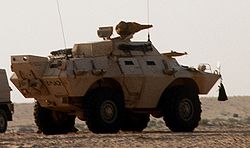
A Saudi V-150 in 1991
The SANG was, by tradition, issued equipment not issued to the regular military, it did not possess any tanks but had several thousand wheeled armored fighting vehicles and Armoured personnel carriers. It possessed its own helicopters and light aircraft and all the remaining types of military hardware including artillery.
A $2.2 billion foreign military sale contract delivered 724 LAV‑II 8×8 wheeled armored personnel carriers in ten different varieties in 2001.
In December 2012, the Saudi National Guard ordered 68 French Multi-Purpose Combat Vehicle (MPCV) air-defense vehicles.[6]
| Model | Image | Origin | Variant | Quantity | Details |
|---|---|---|---|---|---|
| Small arms | |||||
| FN Five-Seven |  |
Belgium | |||
| AK-47 | USSR | ||||
| H&K G36 |  |
Germany | |||
| FN FAL | Belgium | Used for ceremonial purposes. | |||
| FN F2000 |  |
Belgium | |||
| FN P90 |  |
Belgium | |||
| H&K MP5 |  |
Germany | |||
| FN MINIMI |  |
Belgium | |||
| FN MAG | 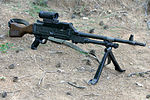 |
Belgium | |||
| WKW Wilk (Tor) | 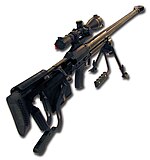 |
Poland | <15 | ||
| Explosives, anti-tank weapons | |||||
| RPG-7 |  |
USSR | |||
| FN GL1 |  |
Belgium | |||
| Mk19 | 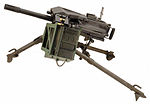 |
United States | |||
| Armored personnel carriers | |||||
| LAV-III |  |
Canada | 19 | 900 LAV 6.0 on order. Some of the 900 combat vehicles will be fitted with a 105 mm anti-tank canon known as the Cockerill CT-CV 105H and the rest will be fitted with a CPWS 20-25-30 which can be armed from a 20 mm to a 30 mm auto-cannon. | |
| Al-Fahd | Saudi Arabia | 100 | First indigenously designed APC. | ||
| Piranha II |  |
Switzerland | 1,117 | 172 more on order. | |
| LAV-25 |  |
United States | Multiple variants | N/A | |
| LAV II | Canada | ten different varieties | 724 | ||
| Cadillac Gage Commando | United States | V-150S | 579+ | between 7 and 10 of the Saudi V-150´s were destroyed when they were used against Iraq | |
| EE-11 Urutu | Brazil | 20 | |||
| Al-Naif | Saudi Arabia | ||||
| Artillery | |||||
| CAESAR |  |
France | 136 | Deal has never been confirmed by NEXTER. Replacement for M102 towed howitzer. First received in 2010 according to Janes. | |
| Aircraft | |||||
| Boeing AH-64 Apache | 
|
United States | 36 | 12 + 24 on order | |
| Boeing AH-6 | 
|
United States | 24 on order | ||
| Sikorsky UH-60 Black Hawk | 
|
United States | 20 on order | ||
| Air Defense | |||||
| MPCV | France | 0 (+68) | |||
| VL-MICA |  |
France | |||
Ranks[]
| File:Saudi Ranks.PNG |
Officers[]
- Lieutenant/Mulazim (Arabic:ملازم)
- 1st Lieutenant/Mulazim Awwal (Arabic:ملازم أول)
- Captain/Naqib (Arabic:نقيب)
- Major/Ra'id (Arabic:رائد)
- Lieutenant Colonel/Muqaddam (Arabic:مقدم)
- Colonel/'Aqid (Arabic:عقيد)
- Brigadier General/'Amid (Arabic:عميد)
- Major General/Liwa (Arabic:لواء)
- Lieutenant General/Fariq (Arabic:فريق)
- General/Fariq Awwal (Arabic:فريق أول)
Enlisted[]
- Private/Jundi (Arabic:جندي)
- First Private/Jundi Awwal (Arabic:جندي أول)
- Corporal/A'rif (Arabic:عريف)
- Sergeant/Wakil Raqib (Arabic:وكيل رقيب)
- Staff Sergeant/Raqib (Arabic:رقيب)
- Master Sergeant/Raqib Awwal (Arabic:رقيب أول)
- Sergeant Major/Ra'is Ruquba (Arabic:رئيس رقباء)
2013 reorganization[]
The SANG was transformed into a ministerial body on 27 May 2013.[7] Prince Mutaib, former commander of the SANG, became the minister of national guard on the same day.[7]
References[]
- ↑ Mackey, p. 207.
- ↑ "History of the Saudi National Guard". 11 September 2006. http://www.aawsat.net/2006/09/article55265322. Retrieved 5 April 2013.
- ↑ Saudi king transfers National Guard duties to son
- ↑ 4.0 4.1 Stanton, Lt Col Martin N. (March–April 1996). "The Saudi Arabian National Guard Motorized Brigades". Armor (magazine). pp. 6–11. https://www.knox.army.mil/center/ocoa/armormag/backissues/1990s/1996/ma96/2saudi96.pdf.
- ↑ Saudi Arabian National Guard
- ↑ Saudi Arabia National Guard ordered 68 MPCV air defense vehicles - Army Recognition, 26 December 2012
- ↑ 7.0 7.1 "King Abdullah transforms National Guard into ministry". 28 May 2013. http://www.aawsat.net/2013/05/article55303379. Retrieved 29 May 2013.
- Mackey, Sandra. The Saudis: Inside the Desert Kingdom. Updated Edition. Norton Paperback. W.W. Norton and Company, New York. 2002 (first edition: 1987). ISBN 0-393-32417-6 pbk.
- Jean R. Tartter. "Saudi Arabian National Guard". Saudi Arabia: A country study. Federal Research Division of the Library of Congress of the USA.
This article incorporates text from this source, which is in the public domain.
External links[]
| Wikimedia Commons has media related to Saudi Arabian National Guard. |
- Official site
- SANG Health Affairs official site
- Global Security Article
- Office of the Program Manager, Saudi Arabian National Guard Modernization Program - OPM-SANG
The original article can be found at Saudi Arabian National Guard and the edit history here.
